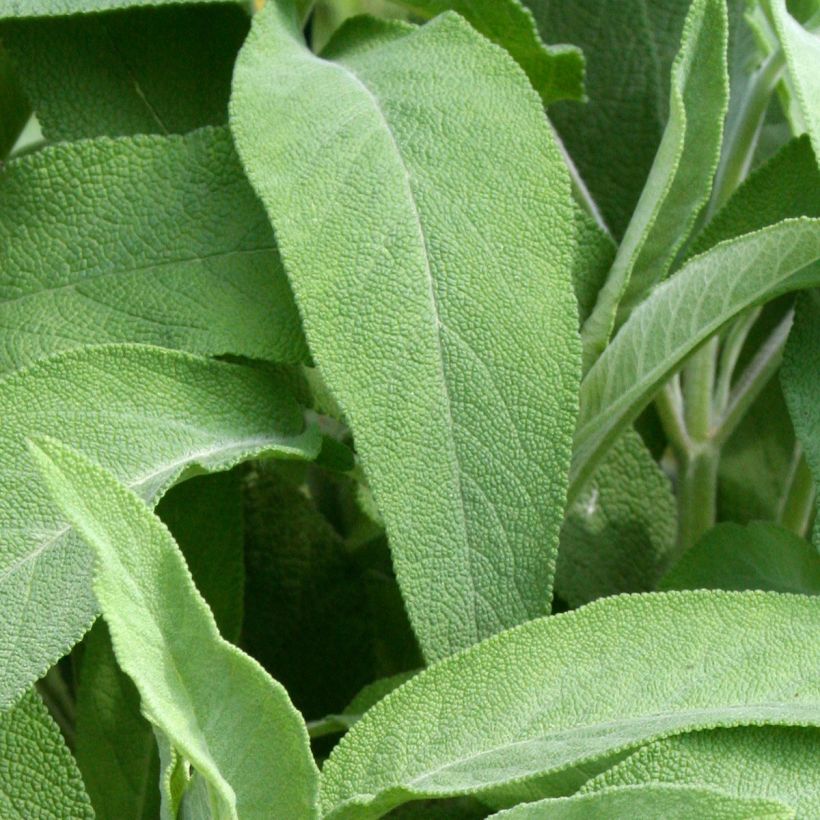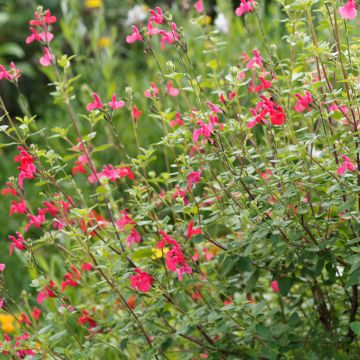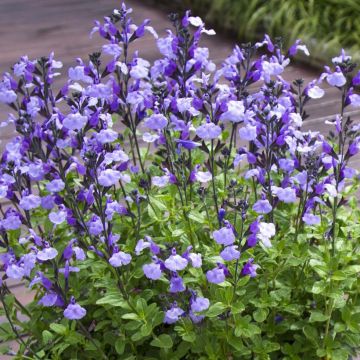

Sauge officinale Elephant Ear - Salvia officinalis
Salvia officinalis Elephant Ear
Salvia officinalis Elephant Ear
Common Sage, Garden Sage, Culinary Sage, Broadleaf Sage
Perfect! A huge thank you to the whole team
Claudine, 04/01/2026
Special offer!
Receive a €20 voucher for any order over €90 (excluding delivery costs, credit notes, and plastic-free options)!
1- Add your favorite plants to your cart.
2- Once you have reached €90, confirm your order (you can even choose the delivery date!).
3- As soon as your order is shipped, you will receive an email containing your voucher code, valid for 3 months (90 days).
Your voucher is unique and can only be used once, for any order with a minimum value of €20, excluding delivery costs.
Can be combined with other current offers, non-divisible and non-refundable.
Home or relay delivery (depending on size and destination)
Schedule delivery date,
and select date in basket
This plant carries a 6 months recovery warranty
More information
We guarantee the quality of our plants for a full growing cycle, and will replace at our expense any plant that fails to recover under normal climatic and planting conditions.

Description
Salvia officinalis 'Elephant Ear' is a cultivar of sage that stands out for its large, particularly flavourful leaves, with a very fresh aroma and a hint of oyster taste. They are especially appreciated in Italian cuisine. It is a very hardy and undemanding perennial plant. In this variety, the summer flowering is classic, with spikes of blue. This lovely plant with medicinal properties can be grown in pots or in the ground. Plant it in the sun, in well-prepared and properly drained soil. Prune it quite short in spring to encourage the production of new vigorous shoots.
The culinary sage 'Elephant Ear' comes from the botanical species Salvia officinalis. Its leaves are commonly used in Italian cuisine. It is used in dishes with pork and lamb, fish, sausages, cheese, and white beans, for example. This perennial plant has a bushy, compact, slightly spreading habit and generally measures between 40 and 60 cm (16 and 24in) in height and 50-60 cm (20-24in) in width. Its square-sectioned stems have a woody base. Its large, oval, slightly rough leaves are green-grey and very fragrant when crushed. It is a very hardy plant, down to -15°C (5°F), that can be grown both in vegetable and ornamental gardens. The flowering takes place between June and August, depending on the climate, in the form of spikes of mauve flowers with purple bracts, which are visited by bees and other pollinators. Sage belongs to the Lamiaceae family, like thyme, savoury, and lavender.
Sage was used in Antiquity and was very present in the Middle Ages, where it had a place in the medicinal garden. "Those who have sage in their garden do not need a doctor" is a saying that shows the importance given to the medicinal virtues of Salvia officinalis, also called "the saving plant". Sage is indeed known for its diuretic, tonic, antiseptic, antiperspirant, and antispasmodic properties.
In cooking, fresh or dried leaves flavour fish, poultry, sauces, and vegetables. Add the leaves at the end of cooking to preserve their aroma. They can also be used in infusions.
Harvesting: The leaves are harvested from March to October, ideally in the morning. Regular harvesting will promote the development of new shoots. The fragrance will be more intense in spring, just before flowering.
Storage: Fresh Sage leaves can be stored in the refrigerator for a few days. For longer storage, you can dry the branches in the shade and keep the leaves in airtight jars for several months.
Gardener's tip: In the garden, mix genres by planting some herbs like Sage in the middle of your perennial borders or even in rock gardens. They will integrate perfectly and the scents of aromatic plants often have the ability to repel insects that may attack more sensitive plants like certain roses.
Salvia officinalis Elephant Ear in pictures


Harvest
Plant habit
Foliage
Other Salvia - Bushy Sage
View all →Planting and care
The 'Elephant Ear' Sage appreciates light, well-drained, rich, occasionally moist to dry and slightly alkaline soils. Plant it in full sun. Planting should be done in spring or early autumn.
In the ground: Space the plants 50 cm (20in) apart in rows with 80 cm (32in) between rows. Dig a hole (3 times the volume of the root ball), place the root ball and cover with fine soil. Firmly press down and water. Regularly hoe and weed, especially at the beginning of cultivation.
Add well-rotted compost every year.
During cultivation, water moderately as Sage is sensitive to excess moisture, especially in winter. Only water a well-rooted plant in case of a very dry summer.
You can propagate Sage by dividing the clumps in spring, thus allowing the plants to regenerate and be placed in another location in the garden. This operation is recommended every 5 years or so.
In late winter, lightly prune to maintain its bushy habit.
In a pot: Place a layer of gravel or clay pellets at the bottom of the pot to facilitate drainage. Fill the pot with a mixture of potting soil, garden soil, and sand. Place the root ball, cover with soil and firm down. Water. Place the pot in the sun and bring it indoors in case of frost.
Cultivation
Care
Intended location
Planting & care advice
-
, onOrder confirmed
Reply from on Promesse de fleurs
Haven't found what you were looking for?
Hardiness is the lowest winter temperature a plant can endure without suffering serious damage or even dying. However, hardiness is affected by location (a sheltered area, such as a patio), protection (winter cover) and soil type (hardiness is improved by well-drained soil).

Photo Sharing Terms & Conditions
In order to encourage gardeners to interact and share their experiences, Promesse de fleurs offers various media enabling content to be uploaded onto its Site - in particular via the ‘Photo sharing’ module.
The User agrees to refrain from:
- Posting any content that is illegal, prejudicial, insulting, racist, inciteful to hatred, revisionist, contrary to public decency, that infringes on privacy or on the privacy rights of third parties, in particular the publicity rights of persons and goods, intellectual property rights, or the right to privacy.
- Submitting content on behalf of a third party;
- Impersonate the identity of a third party and/or publish any personal information about a third party;
In general, the User undertakes to refrain from any unethical behaviour.
All Content (in particular text, comments, files, images, photos, videos, creative works, etc.), which may be subject to property or intellectual property rights, image or other private rights, shall remain the property of the User, subject to the limited rights granted by the terms of the licence granted by Promesse de fleurs as stated below. Users are at liberty to publish or not to publish such Content on the Site, notably via the ‘Photo Sharing’ facility, and accept that this Content shall be made public and freely accessible, notably on the Internet.
Users further acknowledge, undertake to have ,and guarantee that they hold all necessary rights and permissions to publish such material on the Site, in particular with regard to the legislation in force pertaining to any privacy, property, intellectual property, image, or contractual rights, or rights of any other nature. By publishing such Content on the Site, Users acknowledge accepting full liability as publishers of the Content within the meaning of the law, and grant Promesse de fleurs, free of charge, an inclusive, worldwide licence for the said Content for the entire duration of its publication, including all reproduction, representation, up/downloading, displaying, performing, transmission, and storage rights.
Users also grant permission for their name to be linked to the Content and accept that this link may not always be made available.
By engaging in posting material, Users consent to their Content becoming automatically accessible on the Internet, in particular on other sites and/or blogs and/or web pages of the Promesse de fleurs site, including in particular social pages and the Promesse de fleurs catalogue.
Users may secure the removal of entrusted content free of charge by issuing a simple request via our contact form.
The flowering period indicated on our website applies to countries and regions located in USDA zone 8 (France, the United Kingdom, Ireland, the Netherlands, etc.)
It will vary according to where you live:
- In zones 9 to 10 (Italy, Spain, Greece, etc.), flowering will occur about 2 to 4 weeks earlier.
- In zones 6 to 7 (Germany, Poland, Slovenia, and lower mountainous regions), flowering will be delayed by 2 to 3 weeks.
- In zone 5 (Central Europe, Scandinavia), blooming will be delayed by 3 to 5 weeks.
In temperate climates, pruning of spring-flowering shrubs (forsythia, spireas, etc.) should be done just after flowering.
Pruning of summer-flowering shrubs (Indian Lilac, Perovskia, etc.) can be done in winter or spring.
In cold regions as well as with frost-sensitive plants, avoid pruning too early when severe frosts may still occur.
The planting period indicated on our website applies to countries and regions located in USDA zone 8 (France, United Kingdom, Ireland, Netherlands).
It will vary according to where you live:
- In Mediterranean zones (Marseille, Madrid, Milan, etc.), autumn and winter are the best planting periods.
- In continental zones (Strasbourg, Munich, Vienna, etc.), delay planting by 2 to 3 weeks in spring and bring it forward by 2 to 4 weeks in autumn.
- In mountainous regions (the Alps, Pyrenees, Carpathians, etc.), it is best to plant in late spring (May-June) or late summer (August-September).
The harvesting period indicated on our website applies to countries and regions in USDA zone 8 (France, England, Ireland, the Netherlands).
In colder areas (Scandinavia, Poland, Austria...) fruit and vegetable harvests are likely to be delayed by 3-4 weeks.
In warmer areas (Italy, Spain, Greece, etc.), harvesting will probably take place earlier, depending on weather conditions.
The sowing periods indicated on our website apply to countries and regions within USDA Zone 8 (France, UK, Ireland, Netherlands).
In colder areas (Scandinavia, Poland, Austria...), delay any outdoor sowing by 3-4 weeks, or sow under glass.
In warmer climes (Italy, Spain, Greece, etc.), bring outdoor sowing forward by a few weeks.




















































